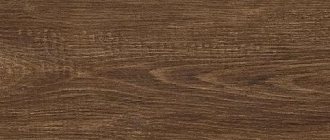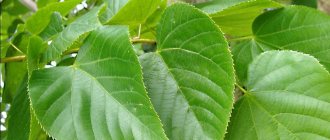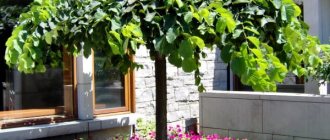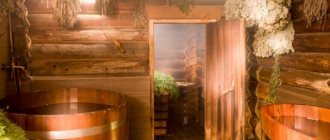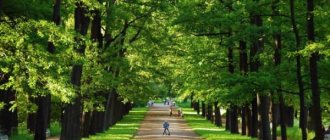Pine (from the Latin Pinus) is the name of evergreen trees, shrubs and dwarf trees of the Pine family, which are distinguished by needle-like needles, growing in bunches of 2-5 pieces and lignified cones. Pine has flaky bark and a developed root system that penetrates deep underground and spreads around the tree. Pine roots develop in accordance with the characteristics of the soil, which is why they are called “plastic”. Due to this property, pine is used for artificial afforestation of unfavorable arid, swampy or poor soils.
The average lifespan of a pine tree is 350 years; the maximum height of pine trees reaches 75 meters.
In total, about 130 species of pine are known, growing in temperate and subtropical climate zones.
Scots pine (Pinus silvestris) grows throughout Belarus and Russia and is widely harvested for woodworking purposes.
Structure and properties
Pine is a soundwood species. As pine lumber is dried and stored, the color of the core becomes darker, becoming a reddish-brown hue. It should be noted that late pine wood is always darker than early wood.
Tree rings are clearly visible in tangential and radial sections, forming a wavy pattern. Large and numerous resin passages are visible in the form of dark stripes.
Pine texture
Pine wood has medium density, good resistance to decay and high strength. It should be noted that sapwood is less resistant to diseases and insect pests, and therefore requires treatment with protective compounds. Wet sapwood (more than 25%) can be easily affected by fungi that cause blue staining of the wood. This disease does not cause a significant deterioration in the mechanical properties of pine lumber, but the appearance of the products suffers from this.
Pine wood
The uniform texture of pine is determined by the difference in the color of the sapwood and heartwood, early and late wood and the different width of the growth rings. Due to the fact that the structure of late and early wood is very different from each other, pine has low uniform density. Areas of the late annual layer have a density 2-3 times higher than that of the early annual layer.
The thickness of the annual rings can vary, from 2-3 mm to 9-10, with late wood occupying up to 26-28% of the annual layer. Pine harvested in Russian forests has a different number of annual layers per 1 cm; this number ranges from 4 to 14.
In the European north of Russia, “ore” (or “kondova”) pine is harvested. This species grows at higher elevations, preferring sandy and sandy loam soils. The wood of such trees is dense and fine-grained, and has a narrow sapwood. The trunk is straight, with a slight slope, very resinous, with few knots.
In low-lying areas with clay soil, pine trees grow, which are called “myandovo”. They have softer wood, less resinous, and are inferior in mechanical characteristics to “ore”.
In the struggle for a place in the sun, pines grow to great heights, forming smooth cylindrical trunks. This makes it possible to obtain long, smooth lumber without knots. This material can be easily processed with a cutting tool and does not crack when dried. Pine wood has a beautiful, well-defined grain, a pleasant yellow to reddish-brown color, and is widely used in carpentry. It is successfully used by wood carvers for their artistic products.
Based on the resin content in pine wood, two varieties are determined: dried wood chips (another name is dutitsa) and resin. The first has a minimal resin content and is light in weight, while the second is heavily resinous and heavy.
Resinous pine cut against the light
Because of such differences, rafts for river rafting were made only from dry wood chips, and tar was taken out by transport, since there was a high probability that it would sink. But this type of pine wood is very resistant to moisture; drowned logs could lie in water for years and still not lose their properties. It is not for nothing that it was used in the construction of bridges, river and sea piers.
Planting at home
Only those varieties that are capable of forming bonsai are suitable for home cultivation. In addition, some gardeners grow seedlings at home before placing the plant in open ground. However, not all gardeners know how to grow pine from seeds or what rules must be followed.
What varieties can grow in pots?
For keeping in pots, choose dwarf and low-growing pine varieties that adapt to cramped conditions and do not require a significant amount of space. In addition, shrub forms with slow growth are suitable as potted plants.
Today, choosing a dwarf pine variety is quite simple, since there are an abundance of different options in nurseries. It is optimal to grow varieties in pots such as:
- Weymouth pine – Radiata variety
- spinous;
- Mountain - the dwarf variety Pamilio is best suited.
In addition, experienced gardeners also use tall trees for pot growing, which are easily molded and capable of forming bonsai.
How to plant a pine tree in a pot
To grow in a pot, you can buy a ready-made plant seedling from a nursery, or plant the crop from seeds yourself. In the second case, growing pine from seeds is quite difficult; the process requires a lot of effort and patience.
Preparing for landing
When preparing a container for planting a pine tree, not only the age of the plant is taken into account, but also the main characteristics of the tree’s rhizome. Experienced gardeners recommend planting young bushes in pots, which are easier to transplant than stronger and more accustomed crops. The optimal age for transplantation is considered to be the first 3 years. Small pots for such small sprouts are suitable; a liter container will be enough. For larger seedlings, choose containers up to 3 liters.
Preparing pots for planting crops involves making holes for drainage at the bottom of the container. The procedure is very important, since the seedlings cannot tolerate even the slightest stagnation of moisture in the soil. A drainage layer is placed at the bottom of the pot - expanded clay, pebbles, crushed brick or crushed stone. A layer of sand about 5 cm is poured on top of the drainage layer.
Pine grown in pots must receive the optimal amount of nutrients, so it is planted only in high-quality and loose substrate. The predominant content of the soil for pine should be peat-sand substrate. For pine, a soil made up of sand, peat, and humus in a ratio of 1:2:1 is suitable. Before planting, the soil is watered with a weak solution of potassium permanganate or calcined in the oven at high temperature.
Preparing the plant for planting
When buying a ready-made seedling from a nursery, it is best to choose plants in pots so that the roots are completely covered with soil. Pine roots should not be allowed to be exposed to air for more than 10 minutes. Therefore, when transplanting bushes to a new place, keep the rhizome closed as much as possible, without damaging the soil in a coma.
You may be interested in: Maple
How to plant
Planting a ready-made seedling is not difficult; the procedure is carried out by transferring the plant into a new pot along with a lump of earth. In this case, the level of grounding depth in the new pot must coincide with the previous pot. After transshipment, the seedlings are covered with earth, and the soil around them is compacted.
After replanting, gardeners advise mulching the soil with pine bark or fallen pine needles. This way the seedling will receive the necessary nutrition.
Home care
Caring for homemade pine is quite simple, since grown in pots, it does not require special conditions. If you initially place the plant in the right place with moist, cool air, further care will consist of the following steps:
- regular watering - the soil in which the pine tree is planted should always be moist. However, you should not allow moisture to stagnate in the soil. Therefore, gardeners recommend irrigating the soil as the top layer of soil dries;
- the plant does not need frequent feeding. Root formation stimulants are applied as fertilizer twice a year. In addition, complex fertilizers containing mineral components are also applied to the soil twice a season;
- The plant is replanted as it grows, but at least once every 2-4 years. The procedure is carried out in spring or autumn. You can’t replant when it’s blooming or when it’s bearing fruit;
- In order to prevent fungal pathologies that can affect pine, phytosporin is added to the soil once a month.
Mature plants require high-quality lighting. Pots with pine trees should be placed on an east or south window. However, in hot weather it is best to shade the crop to prevent burns on the foliage.
Treatment
For carpentry work, they try to use non-resinous pine wood. Processing wood with a high resin content is difficult because the tool becomes clogged with resin. Resinous wood waste sticks to it and interferes with work. Sanding such wood is problematic; the sanding paper immediately becomes clogged with resinous dust. The resin bleeds through coatings, spoiling the appearance, and when accidentally heated, it swells, lifting the paint or varnish layer. Therefore, if it is necessary to use resin, it is treated with chemicals to remove the resin.
Pine wood with a low resin content is easily processed with hand and power tools. Planing along the grain does not cause any difficulties, but cutting across the grain is unsatisfactory and it is difficult to obtain a clean end cut. The wood lends itself very well to sanding operations; the surface quality is better than that of oak or ash.
It can be painted with stains and mordants, but sometimes the resin has a negative effect on such operations. It is easily painted with varnishes and paints, but wood has high moisture permeability, which leads to increased consumption of such materials.
The pine glues well, the connection using fasteners (nails, screws) is satisfactory. Among all the coniferous tree species from which commercial wood is harvested, pine rightfully takes first place. Pine wood comes to the consumer in the form of round timber and lumber (boards, beams). Materials made from pine wood - chipboard, plywood and veneer - are also widely represented on the market. Manufacturers also offer ready-made building structures made of pine - doors, windows, etc.
Wintering
All types of pine, which even naturally grow in warm climates, are resistant to cold. Starting in autumn, the plant gradually slows down its growth rate, but does not stop completely even in winter. Therefore, garden crops must be prepared in time for the wintering period:
- in mid-November, moisture-recharging irrigation is carried out - a dump is first made around the tree trunk circle;
- in mid-September, the last fertilizing of the crop is carried out - phosphorus-potassium fertilizers are added to the soil;
- A layer of mulch is laid around young trees - a thick layer of sawdust, peat or dry leaves.
With the onset of cold weather and snowfall, young pines are covered with a thick snowdrift, covering the trunk with snow. In this state, pine trees survive severe frosts well. In the spring, with the end of severe cold, the snowdrift is gradually removed to prevent rotting and rotting of the rhizome.
Physical properties of pine
Humidity
The sapwood of a growing tree has high humidity, reaching up to 120%. The core has lower humidity (2.5-3 times less than the moisture content of sapwood) and practically does not change with the height of the tree.
At different times, the value and moisture content of wood is different. In the morning, the humidity level is 25-30% higher than the average and reaches its maximum. During this period, this indicator gradually decreases to a minimum (30-35% below the average level). In the evening and night hours there is an increase in humidity.
Drying
Before use, pine wood is dried to a standard moisture content of 12%. Drying can be either natural, in the open air under canopies, or in special dryers. Pine is less susceptible to warping and cracking when dried. Choosing the optimal mode in the drying chamber and proper stacking of lumber allows you to reduce the percentage of rejects to a minimum.
Density
Coniferous wood, including pine, has a low density. The average density of pine wood (at a humidity of 12%) ranges from 500 to 520 kg/cub.m. Density limits range from 350 to 800 kg/cub.m.
Permeability
Pine wood is characterized by high values of moisture permeability and air permeability. The values of these indicators are determined by creating an excess pressure of 0.1 MPa on one side of the sample. For the core this value is 2.6 cubic mm/sq.cm/s, for sapwood - 56.2 cubic mm/sq.cm/s. It can be noted that the same indicator for oak wood does not exceed 0.13 cubic mm/sq.cm/s.
Having such high moisture permeability rates, pine is easily impregnated with various antiseptics and protective compounds.
Thermal properties
In terms of its thermal conductivity characteristics, pine wood significantly exceeds metals (in particular, aluminum) and slightly exceeds polyvinyl chloride. That is why windows made from pine are superior in performance to windows made from aluminum profiles.
Mechanical properties of pine
Strength
Pine wood, harvested in the north of the European part of Russia, has the best mechanical strength. In terms of strength characteristics, only Caucasian fir has the best performance.
Care
Despite the fact that caring for pine is not difficult, care requires compliance with certain rules.
Watering
Pine is resistant to drought, so natural precipitation in the form of rain is sufficient for mature crops. Young plants require watering only during dry periods. In addition, young plants are watered immediately after leaf fall. For optimal development, a young pine tree only needs 1-2 buckets of water for irrigation.
Top dressing
An evergreen tree requires high-quality feeding in the first years after cultivation. Mineral complexes are used as fertilizer. Fertilizing is applied once per season along with watering.
5 years after planting, it is no longer necessary to feed the pine tree, since it will have enough fertilizers that the soil accumulates. To improve the quality of growth and the amount of organic matter in the soil, gardeners recommend not removing fallen pine needles and small parts of the tree from the area around the crop.
Air humidity
Pines are moisture-loving plants and do not like dry air, so it is better to grow the crop in regions with an optimal mild climate. In addition, the tree responds positively to irrigation from a sprayer. Adult crops do not require additional air humidification.
Transfer
Pine does not tolerate transplantation well, so whenever possible, seedlings are immediately placed in a permanent habitat. If necessary, the crop can be replanted only during the first 5 years of cultivation, until it has grown. Before transplanting, they pass around the plant with a bayonet shovel, cutting off the rhizome along the trunk circle.
The place for replanting the plant is prepared in advance, since the roots of the pine tree should not be exposed. The planting pit is prepared according to the size of the rhizome, increasing the depth of the hole so that the roots are free to be with it.
The dug pine tree is carefully removed from the ground and immediately transferred to a new place so that the soil remains on the roots. The crop is immediately buried in a new planting hole, then watered. The first weeks after transplantation, as in the case of initial planting, the plant is shaded.
Trimming
Only dwarf pines that tolerate crown molding are subject to pruning. The remaining crops do not need replanting. Some gardeners prune pine trees to slow down the growth of the pine tree and make the crop more lush and neat. In this case, gardeners break off the young shoots of the plant.
Technical and operational properties
Pine wood is soft and can be easily processed with carpentry tools.
Products made from pine are easily sanded, forming a surface of a high class of cleanliness; micro-irregularities in height do not exceed 60 microns. In terms of these indicators, pine exceeds maple and ash, in which microroughness reaches a value of 200 microns, which is due to the structure of the wood of these species.
Pine is moderately resistant to damage by fungi and insect pests. The kernel is more resistant to biological influences compared to sapwood.
See also:
Wood species
Wood processing
Join the VKontakte and Odnoklassniki groups
Contraindications
The product is prohibited for use in the presence of individual intolerance and allergic reaction.
The product is prohibited for use in the presence of individual intolerance and allergic reaction. In this case, shortness of breath, suffocation, difficulty breathing, arrhythmia, and increased heart rate are possible. Headache, tinnitus, dizziness, rash, redness, itching, burning may also occur. Allergies are dangerous because in severe cases life-threatening conditions arise - bronchospasm, Quincke's edema. Regardless of the purpose - skin care, hair care, nail plates or treatment of diseases - you must first do an allergy test.
Contraindications to the use of pine oil:
- during pregnancy;
- breast-feeding;
- children under 12 years of age;
- angina pectoris;
- history of myocardial infarction;
- severe kidney diseases - nephrosis, nephrosonephritis, pyelonephritis;
- gastritis, ulcerative lesions of the gastrointestinal tract.
Apply pine ether yourself only externally.
Coniferous oil is widely used in traditional medicine and cosmetology recipes.
When used internally, it is important to follow the recommendations of the herbalist and not exceed the prescribed dosage. Apply pine ether yourself externally only.
Taxonomy [edit | edit code ]
- Pinus binatofolio Gilib.
- Pinus borealis Salisb.
- Pinus cretacea Kalen.
- Pinus ericetorum Thore
- Pinus erzeroomica Calvert ex Gordon
- Pinus fominii Kondra.
- Pinus frieseana Wich.
- Pinus genevensis Carriere
- Pinus genovensis Garsault
- Pinus hagenaviensis K.Koch
- Pinus krylovii Serg. & Kondra.
- Pinus lapponica (Hartm.) Mayr
- Pinus montana Hoffm.
- Pinus mughus Jackq.
- Pinus resinosa Savi
- Pinus rigensis Loudon
- Pinus rubra Mill.
- Pinus tartarica Mill.
Varieties [ edit | edit code ]
In different parts of the range, scientists have identified varieties of Scots pine, as well as morphological and ecological forms - ecotypes, which are characteristic of certain areas of growth.
Currently, scientists are considering 3 valid subspecies of Scots pine:
- Pinus sylvestris var. hamata Steven - grows on the Balkan Peninsula, in northern Turkey and Transcaucasia, at an altitude of 500-2600 m above sea level.
- Pinus sylvestris var. lapponica - grows in Norway, Sweden, Finland and adjacent territories of Russia north of 65° north latitude (northern Karelia and Murmansk region). On the Solovetsky Islands in the White Sea, its growth is up to 30 m [7]. The needles are shorter and stiffer. The seeds are yellowish-brown. It often forms a creeping shrubby form [8].
- Pinus sylvestris var. mongolica Litv. - grows in Mongolia, northwestern China and southern Siberia, at an altitude of 300-2000 m above sea level. It occupies large areas in Transbaikalia; in other places it prefers dry and sandy soils. In the Sokhondo Nature Reserve in Transbaikalia, a tree grows 42 m high [7].
Ecotypes [edit | edit code ]
Due to the wide range of Scots pine, extending over significantly ecologically different areas, this species is characterized by a very significant number, up to 30, ecotypes identified by ecologists. For example, Angara pine, an ecotype of Scots pine, grows in the Angara River basin.
The formation of distinctive ecotypes in natural conditions contributed to the emergence of a large number of scientific names synonymous with the species, which currently have the status of nom. illeg. or nom. inval. and are not used in taxonomy.
Characteristics
Ship pines are those that reach a height of about 40 m by the age of 80-100 years and have a straight trunk with a diameter of 0.5 m without knots. The main characteristics of such trees:
- the wood is light, resinous, durable, strong, elastic;
- tall pine;
- The trunk is erect, fairly uniform in height, without knots.
Pines cope well along the river and do not rot, thanks to their low weight and resin. In shipbuilding, the part of the tree was taken into account, and in which direction of the world this or that part was directed. There are no branches at the base of the trunk and the wood fibers are straight, so the log is suitable for keeling or sawing into long boards. On the north side, the tree receives less light and heat, so the structure is formed more dense and finely layered, used for the construction of the most important parts.
Mast pine must be at least 0.5 m in diameter; only slender, tall specimens are suitable for making durable ship masts. Less strong varieties were used for the construction of improvised means and scaffolding. Pine resin was used to impregnate the fabric of sails, ropes, and grooves.
Ship pines are those that reach a height of about 40 m by the age of 80-100 years.

